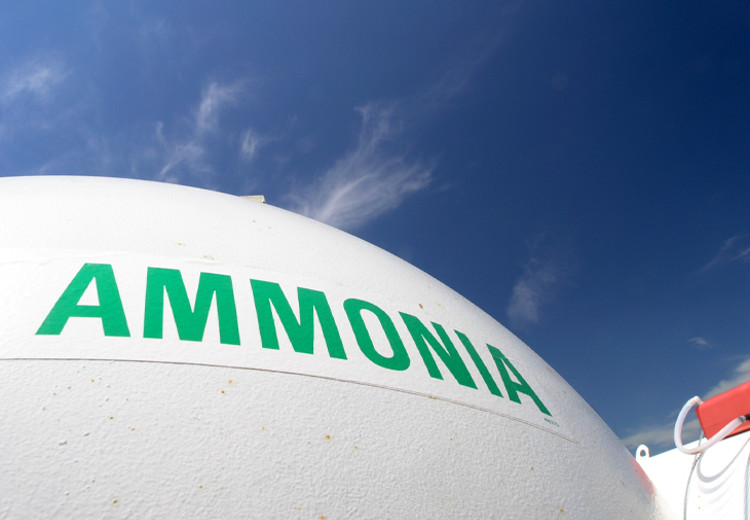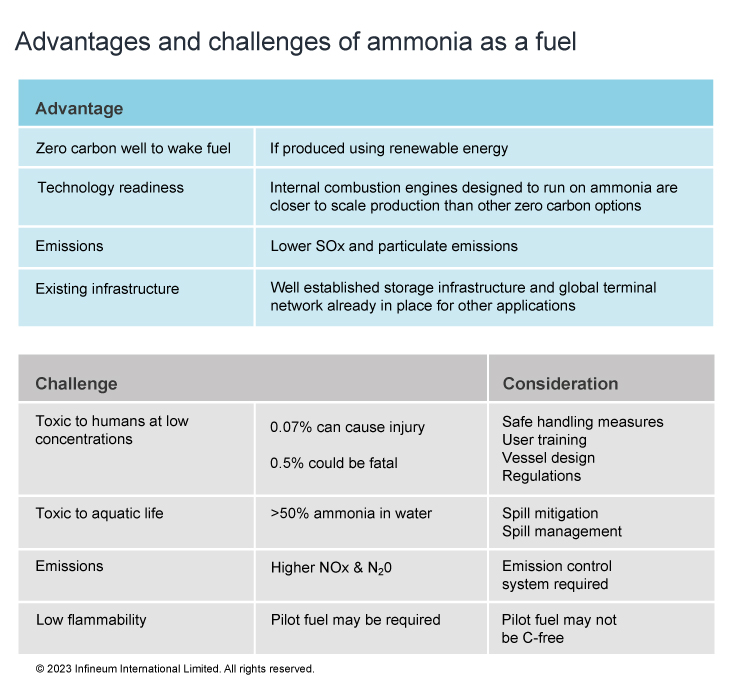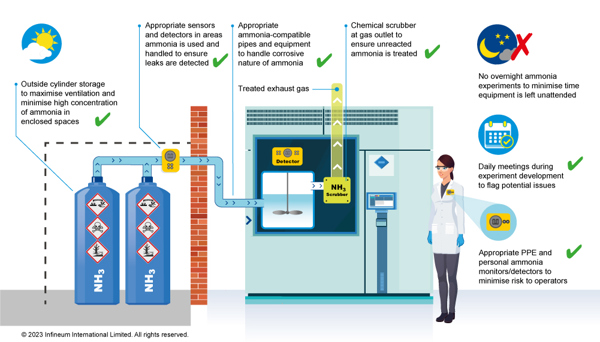Fuels
Fuel additive sea trials
08 July 2025
12 December 2023
Marine sector set to embrace new low and zero carbon fuels en route to net zero emissions

With the first carbon intensity ratings for international shipping on the near horizon, the marine industry is looking for cost effective and readily available carbon reduction strategies. But, at the same time, the industry must look further ahead as the International Maritime Organization (IMO) pushes accelerated ambitions for greenhouse gas reduction, while pursuing a path to net zero by 2050. Toby Stein, Infineum Business Transformation Manager, looks at the transition paths and, as the industry pins its hopes on ammonia as a viable zero carbon solution, explores the challenges ahead and shares the safe practices Infineum is adopting in its research programme.
In July 2023, to ensure greenhouse gas (GHG) emissions from international shipping do not continue to rise, IMO adopted its revised GHG strategy, which calls for a reduction in CO2 emissions of at least 40% by 2030 and 70% by 2040 compared to 2008. The new levels of ambition also call for the uptake of zero or near zero GHG technologies/fuels/energy sources to represent at least 5% of the energy used by international shipping in 2030. These initiatives are in pursuit of IMO’s net zero by 2050 ambition and to achieve them action must be taken today.
Throughout 2023, fuel consumption reporting for the IMO carbon intensity indicator (CII) has been underway. Ships will receive their first rating from A to D in January, vessels rated D for three consecutive years or rated E must develop and implement corrective actions to achieve the minimum C rating.
In the near term, industry attention is focussed on the most cost effective and easy to implement ways to gain and retain a C or better CII rating.
In addition, with sustainability and net zero ambitions being published by organisations across the marine industry supply chain, the adoption of lower emissions pathways is becoming the key focus of the entire industry.
As we have seen in other transportation modes, the use of low carbon energy sources is an effective GHG reduction strategy. While the marine world is considering a wide range of technical and operational decarbonisation options, fuel selection has some of the greatest potential to reduce GHG emissions in this sector. Currently a range of alternative fuel options are being explored, although each has its own set of challenges and in some cases deeper investment is required in the commercialisation, supply chain and refuelling infrastructure. In the short term, we can expect an uptake of already available lower carbon fuels, such as biofuels, LNG/LPG, ethanol and methanol as the industry transitions towards net-zero.
Given the need for shippers to improve efficiency, reduce running costs, while also ensuring reliable operation, Infineum has invested in the development of marine additive technologies.
Fuel combustion and lubricity improvers, wax and asphaltene management additives and an additive package for 40 BN (base number) marine diesel cylinder lubricants (MDCL) meeting MAN ES category II lubricant standards, have been designed to help create a more sustainable future through innovative chemistry.
As we look further ahead, the need to work towards net zero emissions from international shipping by 2050 means other energy sources must be considered.
The three most suitable ultra-low/zero-carbon options for the marine industry are green hydrogen, green ammonia and green methanol – with the latter in use today and ammonia looking to be the most promising zero carbon option. This is largely owing to its comparatively higher energy density and the wealth of existing knowledge on ammonia handling, storage and safety and the existing infrastructure. Two-stroke large engine OEMs, such as MAN ES and WinGD, have signposted their new engine designs and retrofitting strategies to enable ammonia adoption. For example, in July MAN ES announced its successful first running of a two-stroke test engine on ammonia at its Research Centre Copenhagen. The organisation says it broadly expects to hold its delivery timeline for the first ammonia engine, with subsequent operation onboard a commercial vessel from around 2026. In October, Exmar LPG BV announced it will have the first ocean going vessels to be propelled by dual fuel ammonia engines. Engine supplier WinDG says the engines for these two LPG/ammonia carriers will be delivered in Q2 2025 and will be among the first of WinGD’s ammonia-fuelled engines to enter service.
We are also seeing more initiatives to create Green Corridors, which are specific shipping routes where the economics, infrastructure, and logistics of zero- or near-zero emission shipping are more feasible and rapid deployment can be supported by targeted policy and industry action. In its 2022 report on progress, the Global Maritime Organisation says 21 initiatives have emerged around the world. More than 110 stakeholders from across the value chain are engaged in these initiatives, and a significant level of public-private collaboration can be seen. One major example is the Australia-East Asia iron ore trade route where it is thought that ships powered by green ammonia could be deployed by 2028.
And, it’s not only the marine industry that is looking at ammonia as a fuel, there is also growing interest in ammonia as a carbon free fuel for combustion engines used in power generation as well as in mining and long-haul vehicle applications.
Clearly there are advantages to using ammonia, but we can also anticipate a number of new and complex challenges across the marine industry supply chain related to its safe storage, bunkering and consumption. The key concern is that ammonia is extremely toxic to humans, posing a danger to those who handle, store and use the chemical.

With technology in the marine world in the early stages of development and testing, there is limited operational experience of ammonia fuelled vessels – which makes definitive answers on safety hard to obtain. However, valuable insights from its use in adjacent industries, for example industrial refrigeration and fertilizer production, along with feasibility studies and safety assessments of proposed vessel designs will help to guide the industry on this journey.
Lloyd’s Register, a leading provider of classification and compliance services to the marine and offshore industries, has identified safer designs, risk assessment and mitigation as paramount in enabling ammonia adoption by the marine sector.
In a report resulting from a collaboration between the Lloyd’s Register Maritime Decarbonisation Hub and the Mærsk Mc-Kinney Møller Center for Zero Carbon Shipping, onboard safety risks of ammonia have been assessed. They have concluded that the risks can be kept within tolerable limits provided the industry can:
With the insightful recommendations and findings from this study, the maritime sector can proactively steer regulatory frameworks, industry guidelines, and best practices towards ensuring that ammonia-fuelled vessels meet acceptable safety standards for crew members.
Infineum is actively working to understand the hardware and lubrication issues associated with ammonia use in marine vessels. Since safety is the key industry concern at this stage of its deployment, we started our own ammonia studies from a position of safe handling.
Combining previous experience of using ammonia in a laboratory with external inputs on handling ammonia, we developed a series of engineering and administrative mitigations regarding its use. These are designed to ensure safe environments for our operators using ammonia in both bench and engine tests.

Drawing parallels with the concerns faced by crew members aboard ammonia-powered vessels, our operators must have a comprehensive understanding of the associated risks and be equipped with essential safety protocols to troubleshoot any potential technical issues that may arise during the operation of test rigs. While the handling of ammonia may not markedly differ from the handling of other hazardous chemicals encountered in a laboratory, along with robust engineering safeguards, the critical emphasis remains on the operator’s vigilance and their proactive approach to safety.
The engineering and administrative mitigations implemented are strongly aligned with Infineum’s commitment towards employees’ safety. We believe that anyone working for Infineum has the right to return home at the end of each day in the same state of health and wellbeing as they began it, and that all incidents, injuries, and occupational illnesses are preventable.
But, we want to go beyond our own area of operations and have taken steps to share our safety practices and insights with customers, OEMs and with others as they embark on testing ammonia as a fuel. In our view, the implementation of safe handling measures across all relevant sectors will accelerate ammonia adoption and research in a safe manner.
Our next ammonia feature in Insight will look in more depth at the commercialisation of ammonia powered vessels. We will also explore the in-use challenges the fuel presents to lubricants, the technical barriers that need to be overcome to ensure harms free ship operation, the development and testing work Infineum has undertaken already and the future directions we anticipate. Click here to register for free updates.
Sign up to receive monthly updates via email